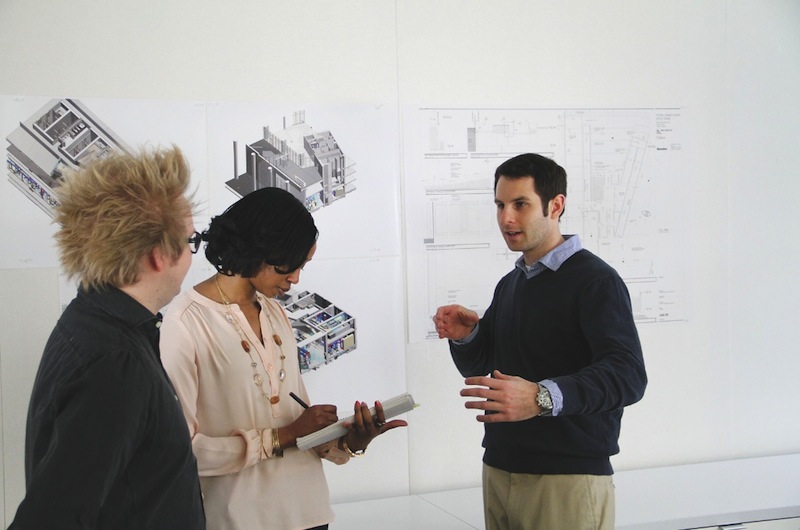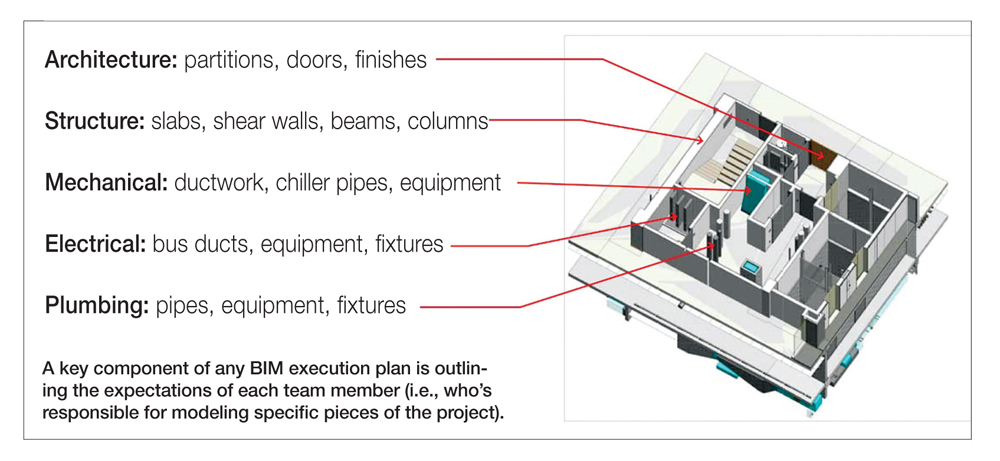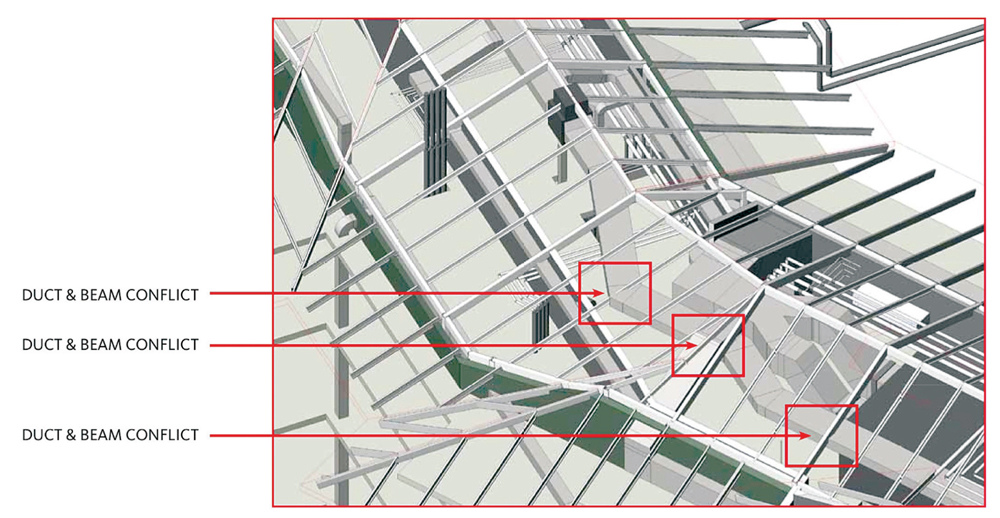Like most heavy-duty BIM users, I experienced that “Eureka!” moment when I became a true believer in the power of this new technology. My epiphany came several years ago, during a nine-hour preconstruction planning meeting with the design-build team for twin, seven-story student residence buildings at George Mason University in Fairfax, Va. As part of the deliverable on the project, each primary consultant—architect, MEP engineers, structural engineer, and contractor—was required to collaborate on a fully integrated Revit model that would be turned over to the client for operations and maintenance purposes.
It wasn’t long into the planning meeting that my teammates and I realized that BIM could be used for more than just a fancy delivery tool.
We had the Revit model open and could instantly see the systems and potential conflicts by cutting sections, looking at 3D views, hiding roof layers, and isolating the structure and mechanical ducts. We found ways we could, as a team, tweak the design and make it more efficient—all because we were revolving around the model and making changes on the fly.
The George Mason University project turned out to be a huge BIM/VDC success story, and our team has gone on to work on other BIM/VDC-heavy projects.
Allow me to share some of the lessons I’ve learned during my five-year BIM/VDC journey.
1. Don’t overcomplicate the BIM execution plan.
A key component of any BIM execution plan is outlining the expectations of each team member (i.e., who’s responsible for modeling specific pieces of the project).
Too often red tape gets in the way of workflow efficiency on BIM/VDC projects. For instance, some building owners hire consultants to manage the BIM process on their behalf; if not done correctly, this can result in the Building Team having to adhere to overly complicated processes and procedures.
I’ve seen BIM execution plans as long as 50 pages, with page after page of information and procedures. Some plans go so far as to point out what abbreviations the team needs to use when naming families in Revit. Is anyone really going to go to the appendix of a 50-page execution plan to look that up when they’re in the middle of modeling a family?
Another pet peeve of mine is BIM execution plans that dictate object modeling procedures. They may, for instance, require that all doors in a BIM project be modeled as simple blocks during the early stages of design and then be converted to smart objects later. That implies that the team will swap out all the doors on a project at every phase. In my opinion, it’s a complete waste of time.
I’ve found that the best way to keep BIM execution plans simple is by following these steps:
• Outline the expectations of Building Team. Have a discussion early on about which team members will be modeling which pieces of the building. For instance, the architect typically starts the structural layout, so the team needs to determine what is expected of the structural engineer and when it needs to be delivered. The architect may drive critical design elements, like slab edge locations, but I prefer that the structural engineer owns the slabs as early in the process as possible.
• Educate the client on the BIM process. Explain how the workflow differs from traditional delivery approaches. What are the schedule impacts? What are the cost impacts? After going through the process a few times, BIM only improves our workflow, and that’s a big plus for clients.
• Create a schedule of expectations. Specifically, where should the model be during the schematic design, design development, and construction document phases? Your MEP engineers will not want to develop their systems too early in the game, but it is important to understand when the major elements need to be modeled and in what phase the details are expected.
• Determine the optimal level of detail. What should be modeled? What should not be modeled? How much detail is required for each aspect of the project?
• Manage consultant grids. Everyone wants to have grids in their model, but when the architect loads five models you could end up with six of the same grid lines on top of each other. I recommend setting up a duplicate workset with the consultants’ grids so they can be turned on and off as needed.
• Establish a model sharing schedule. When conducting a coordination meeting, it is important to have the models downloaded and ready to go in advance.
• Manage the model size. Larger models need to be split up into manageable segments. For example, on a recent built-to-suit corporate headquarters project, our team split the building envelope and cores into a separate model from the interior fitout.
2. Get smart about clash detection.
Krieger and his colleagues at Gensler learned many BIM/VDC lessons while designing the 24-story Tysons Tower project in Tysons Corner, Va. Key takeaways include knowing the level of detail to incorporate in the BIM model and spotting misleading clash detection alerts.
Too often, BIM users rely on the software’s automated clash detection reports to help assess the state of a design project. The problem is that these reports grossly exaggerate the number of clashes on a project and the design team ends up wasting time clearing up hundreds of false hits.
There’s a difference between good modeling and perfect modeling. By following automated clash detection reports as the letter of the law, you can end up wasting hundreds of valuable hours cleaning up a model.
We ran into this problem with the 24-story Tysons Tower project, which is currently under construction in Tysons Corner, Va. In the BIM model, the design team inserted thousands of smart light fixtures that, when triggered, displayed a cone of light to simulate the throw of the fixture in the space.
As a result, every time a cone touched a ceiling or a wall, it would show up as a clash in the automated report. We all knew that wasn’t the case. But you could have a BIM consultant on a project who is telling the client, “Look, we have four thousand clashes and we’re going to solve them for you.” In the end, you’d just waste an enormous amount of time.
My recommendation: concentrate on the areas where you know there are going to be problems. You can’t let the computer do everything. Good architects know where they need to focus their coordination efforts.
I prefer to use the 3D capabilities of BIM to visually coordinate and manage conflicts. A standard project practice should be virtual coordination meetings, where the designers sit in a room and use the model to resolve conflicts collaboratively.
3. Put in prep time for virtual coordination meetings.
There is nothing more frustrating than having someone unfamiliar with the project or BIM software “drive” the project model during coordination meetings. It can kill the momentum of the meeting and ultimately annoy the other team members.
Let’s face it, some people simply aren’t as quick with the computer as others, and they’re slow to know which views to switch to. Not only is it painful to watch, it often leads to an inefficient meeting. At our firm, only team members who are proficient in Revit get to drive the model.
Meeting preparation is also vital. BIM models can be extremely complex, massive files. Even when using the fastest computers available, it can take 30 seconds or longer to generate a specific view in a complex model.
If you’re sitting in a room with 10 other people and there’s a question posed and everyone is throwing out ideas, invariably the room turns to silence while the model is spooling. That can kill momentum.
My teammates and I have learned that 15 or 20 minutes of prep time can go a long way toward running efficient, productive coordination meetings. You need to have views—3D views, sections, and coordination plans, all with the appropriate models loaded—set up before the meeting.
4. Apply the two-inch rule.
This is one of the first rules of designing with BIM, yet I have seen many professionals get it wrong. It goes like this: Anything in a design that is smaller than two inches in size—such as wire, conduit, and pipe—should not be modeled, because small components can usually be worked around larger components on site.
Of course, there are situations where you would want to model small components to that level. For instance, on the Tysons Tower project, we modeled the light fixtures built into the curtain wall to make sure they were designed and built properly. Doing so prevented us from creating two or three other detailed sections. We didn’t have to draw a blow-up elevation or blow-up detail; we created just one axonometric model view.
5. Get to know your subcontractors’ BIM experts.
A project’s success requires subcontractors who are well versed in both engineering and BIM/VDC tools. Otherwise, the team will end up having to spend time bringing them up to speed on the modeling process instead of working on the design and engineering.
Some consultants will tell you they are BIM experts, just to get on a proposal with you. It’s worth it to ask hard questions and even see some examples of their work.
Once you establish a firm’s credentials, find out who its top BIM expert is so you know who to call when a technology emergency arises. Don’t assume that it’s the project manager. You need to know who you can call in a bind.
6. Watch the consultants’ display backgrounds.
Just because multiple team members are referencing the same base model, you can’t assume their background views will look the same.
It is not a simple handoff, like with CAD, where the consultants take the 2D view you set up and turn it into half tones. The Revit model can have all sorts of strange display characteristics in your consultants’ models, which can lead to hiccups.
For instance, the Tysons Tower team received unnecessary comments from the plumbing plan inspector because he could not tell which direction the stairs were facing on the plumbing drawings. It turned out that the model view the plumbing engineer was using to create the plan was not displaying the architecture background properly, which led to the confusion.
There are options in BIM programs—for example, the COPY MONITOR function—where you can capture the exact view and cut plane the consultants need to use. It’s almost like a snapshot of a view that they use as a background.
Like thousands of other design and construction professionals, I’ve learned a lot about making BIM/VDC work over the last five years. My guess is this is just the start of an even longer journey.
While BIM clash detection reports can be helpful in catching serious issues, like the duct and beam conflicts shown above, they tend to also list numerous false clashes. If bogus hits are not identified early on, the team could waste valuable time and resources while attempting to resolve them.
Related Stories
| May 25, 2011
Developers push Manhattan office construction
Manhattan developers are planning the city's biggest decade of office construction since the 1980s, betting on rising demand for modern space even with tenants unsigned and the availability of financing more limited. More than 25 million sf of projects are under construction or may be built in the next nine years.
| May 25, 2011
Olympic site spurs green building movement in UK
London's environmentally friendly 2012 Olympic venues are fuelling a green building movement in Britain.
| May 25, 2011
TOTO tests universal design at the AIA conference
If you could be 80 years old for 30 minutes—and have to readjust everything you think you know about your own mobility—would you do it?
| May 20, 2011
Hotels taking bath out of the bathroom
Bathtubs are disappearing from many hotels across the country as chains use the freed-up space to install ever more luxurious showers, according to a recent USAToday report. Of course, we reported on this move--and 6 other hospitality trends--back in 2006 in our special report "The Inn Things: Seven Radical New Trends in Hotel Design."
| May 19, 2011
BD+C’s "40 Under 40" winners for 2011
The 40 individuals profiled here are some of the brightest stars in the AEC universe—and they’re under the age of 40. These young architects, engineers, contractors, designers, and developers stood out among a group of 164 outstanding entrants in our sixth annual “40 Under 40” competition.
| May 18, 2011
Sanford E. Garner on the profitability of being diverse
Sanford E. Garner, AIA, NOMA, LEED AP ND, NCARB, founding partner and president of A2SO4 Architecture, LLC, Indianapolis, on gentrification, the profitability of being diverse, and his goals as NOMA president.
| May 18, 2011
8 Tips for Designing Wood Trusses
Successful metal-plate-connected wood truss projects require careful attention to detail from Building Team members.
| May 18, 2011
Major Trends in University Residence Halls
They’re not ‘dorms’ anymore. Today’s collegiate housing facilities are lively, state-of-the-art, and green—and a growing sector for Building Teams to explore.
| May 18, 2011
Former Bronx railyard redeveloped as shared education campus
Four schools find strength in numbers at the new 2,310-student Mott Haven Campus in New York City. The schools—three high schools and a K-4 elementary school—coexist on the 6.5-acre South Bronx campus, which was once a railyard.



















